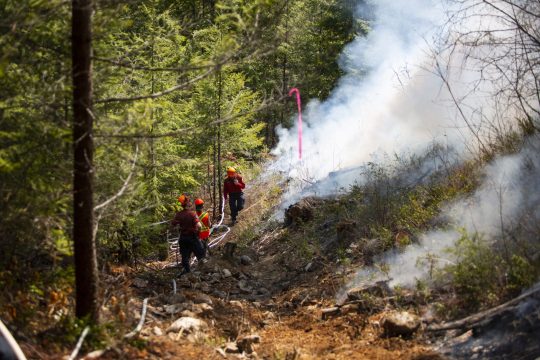The Slocan Valley’s 340,000 hectares of land and water offers both beauty and incredible biodiversity. Home to countless species of flora and fauna, from mighty cedars to delicate wildflowers, and elusive grizzlies to soaring eagles, the vast ecosystem must remain balanced and resilient.
Located in the heart of the valley, the Slocan Integral Forestry Cooperative (SIFCo) manages approximately 16,000 ha of this space. It’s also where it’s implementing its Landscape level Ecosystem, Resiliency, Enhancement and Climate Change Adaptation Project— a comprehensive name that encapsulates the enormous range of actions that SIFCo is taking.
Like many Basin residents, Stephan Martineau is hyper-aware of climate change challenges. As a founding director and Manager of SIFCo, he heads an environmental stewardship team of leaders in climate change adaptation, sustainable forestry practices, community resiliency, wildfire mitigation, ecosystem-based management and economic diversification.
“We use a landscape-level perspective to make the land we manage more resilient to change and more capable of adapting to what’s coming our way,” he says. “That means we plan at a large scale—35,000 acres rather than 200, for example—and since 2008, we’ve been proactive in our response to rapidly changing climate conditions in this bioregion.”
With support from the Trust, SIFCo’s current project is enhancing and restoring ecosystem values and wildlife corridors on hundreds of hectares of locally rare flora and fauna in the Winlaw and Trozzo Creek watersheds. The project has involved four prescribed burns from 2021 to 2023, plus has an upcoming aquatic habitat restoration component.
In these historically fire-maintained ecosystems, controlled fires reset the landscape to a pre-fire suppression era, preserve soil and ecosystem structures, and create fuel breaks. SIFCo’s approach to wildfire mitigation was tested during the 5,992-ha Trozzo Creek fire of 2021, when it played an important role in slowing the spread of the wildfire that threatened Slocan Valley communities.



SIFCo is also implementing aquatic action. This will help redirect rainbow trout and other species of fish from the increasingly warmer summer temperatures of the Slocan River to Winlaw Creek, where their populations have a higher likelihood of thriving.
“Winlaw Creek is well-suited for the creation of new pools and has a canopy to keep water cool longer in the summer season,” Martineau explains.
SIFCo’s various partnerships with organizations like the British Columbia Wildfire Service, Selkirk College and the University of British Columbia create province-wide synergy—and an opportunity to collaborate on proactively building local capacity when it comes to dealing with landscapes in transition.
Martineau is thrilled that this work closely aligns with a Trust program that focuses on maintaining and improving ecological health and native biodiversity in a variety of ecosystems.
“I think we need to focus our attention specifically on large-scale impacts in a specific bioregion, such as the Slocan Valley, when we plan for adaptation,” adds Martineau. “This is one of the programs that actually offers that possibility; it’s great that it exists and it’s a real benefit to Basin communities.”












